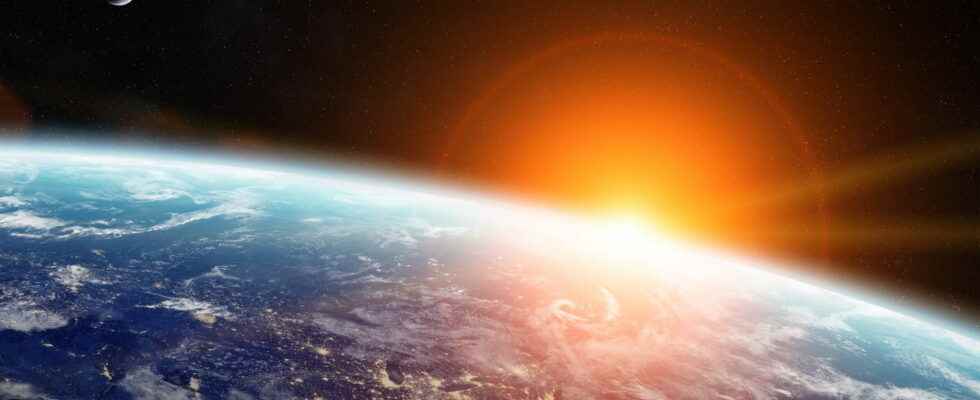EARTH. On January 4, the Earth will pass perihelion. In other words, our planet will reach the point in its orbit closest to the Sun. Explanations, differences with aphelion, we take stock of this phenomenon which takes place every year.
[Mis à jour le 3 janvier 2023 à 17h13] This Wednesday, January 4 at the end of the afternoon, the Earth will pass the perihelion of its trajectory around the Sun. At 5:17:28 p.m. (Paris time) precisely, our planet will reach the point in its orbit closest to our star: the Sun. However, no spectacle will be visible in the sky and this event well known to astronomers should go unnoticed from the ground.
Each year, the Earth reaches this point called perihelion around January 4th. Behind this barbaric name hides a physical phenomenon linked to the shape of the orbit of our planet and the position of the Sun relative to this trajectory. As the year passes and the Earth orbits our star, the distance between these two objects changes. Thus, this distance can vary by 5 million kilometers between the moment when the Earth is at its closest point to the Sun and when it is at its farthest point from the latter. We explain everything about perihelion and its opposite aphelion, the origin of these events and the date on which they occur.
Despite what we imagine, the Earth revolves around the Sun following a trajectory that is not completely circular with the Sun placed in its center. Indeed, the shape of its orbit is slightly elliptical and the Sun is not located in the center of this orbit. As a result, during the year, the distance between the Earth and the Sun varies. We call the point where the Earth passes closest to the Sun: the perihelion.
This year, at the time of its passage through perihelion, our planet will be at 147,098,924.694 kilometers from the Sun. Nowadays, this event takes place around January 4, but this date is gradually shifting each year by about twenty minutes per year, explains the magazine. Science and Future.
Exact opposite of perihelion, aphelion is the point where the Earth passes through the point of its orbit farthest from the Sun. In 2023, the transition of our planet to aphelion will take place on July 6. On this date, the Earth will be at 152,093,250.543 kilometers of our star. This event is linked to the elliptical shape of the Earth’s orbit around the Sun and the fact that the latter is not at the center of this orbit. Aphelion therefore corresponds to the moment when the Earth is at the extremity of the ellipse farthest from our star.
What is the distance between the Earth and the Sun?
The Earth and the Sun are separated by an average of 149,597,870.7 kilometers. This distance corresponds to 1 Astronomical Unit (AU). Created in 1958, this unit makes it possible to express particularly large distances more simply.
How long is the Earth’s revolution?
The revolution of a planet is the time it takes to revolve around its star. The Earth takes 365 days to make a complete revolution around the Sun. In the solar system, the farther the planet is from the Sun, the longer its period of revolution. Thereby, Mercury takes only 88 days to complete a complete revolution around our star, while Neptune takes more than 164 years.
What is the position of the Earth in the solar system?
Earth is located in 3e position in the solar system starting from our star. It is placed between the planets Venus and March. This situation allows it to be in the habitable zone of the solar system, that is to say in an area where the conditions allow the presence of liquid water, a sine qua non condition for the appearance of life.
Who said the Earth rotates?
Until 16e century, the Universe is conceived according to a model established by the astronomer Ptolemy during Antiquity. The latter affirms that the Earth constitutes the center of the Universe and that the planets swim in a fluid around the Earth. This conception of the Universe is called geocentrism and will be admitted and supported by the Church until the 16e century.
Even if theories opposing this model gradually emerge, they do not convince and the Polish canon and astronomer Copernicus is the first to make its voice heard on this subject. According to him, it is the Sun, and not the Earth, which is at the center of the world and the planets revolve around it. This theory is called heliocentrism and lays the foundation for understanding the solar system.
In 1610, the Italian astronomer Galileo publishes the result of his work, stating that the Sun is placed at the center of the Universe and that the Earth revolves around it. This new vision of the world does not please the Church, which is deeply attached to the geocentric conception taught by religious texts. The Catholic Inquisition then imprisons Galileo who will be forced to deny his theories so as not to be burned alive. It is on this occasion that he will pronounce the famous sentence “And yet, it turns!” (“E pure so muove!” in Italian).
His research is deepened by various scientists such as the German Kepler or the Englishman Newton who will demonstrate the earth’s gravity. However, it will be necessary to wait until the 18e century to have proof of the rotation of the Earth around the Sun thanks to the British scientist James Bradley.

